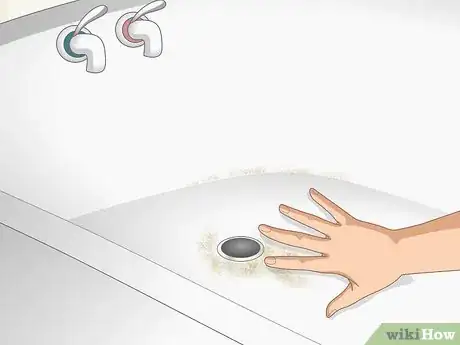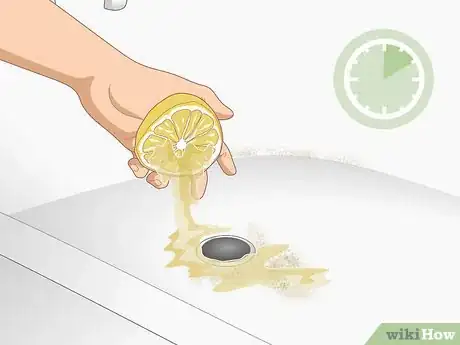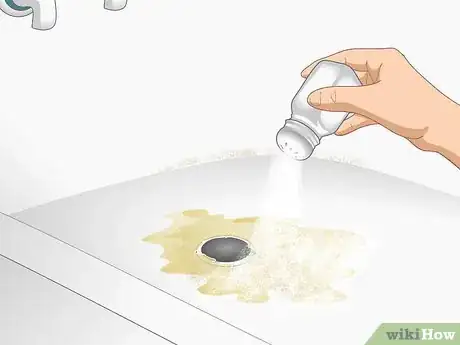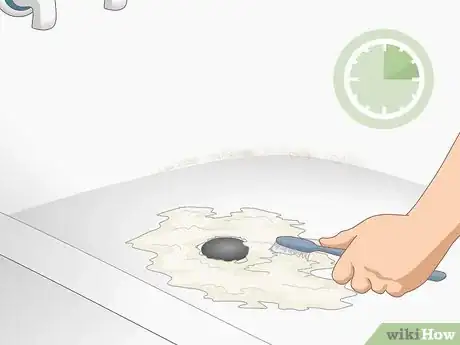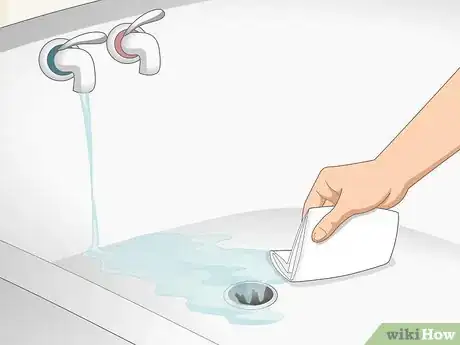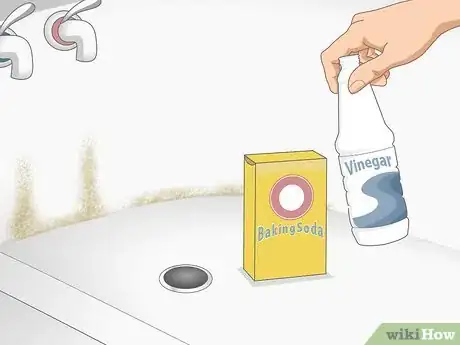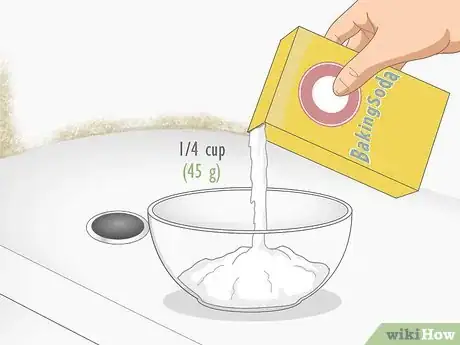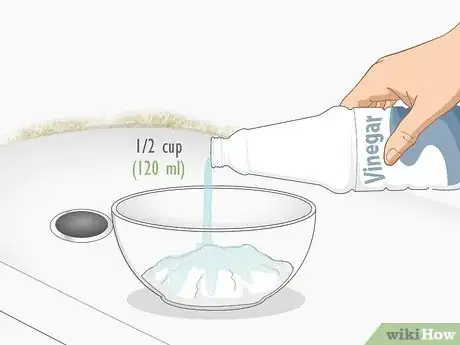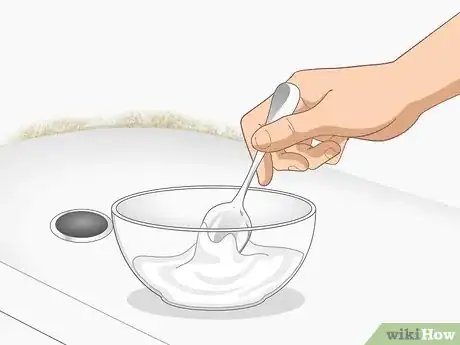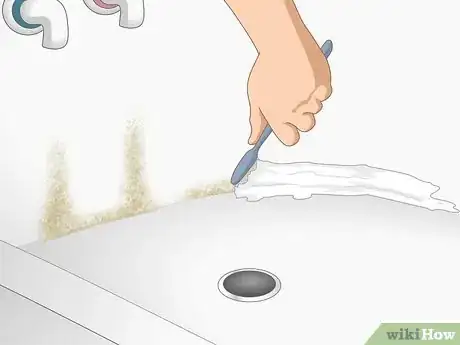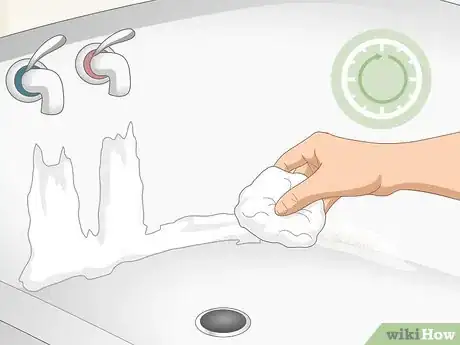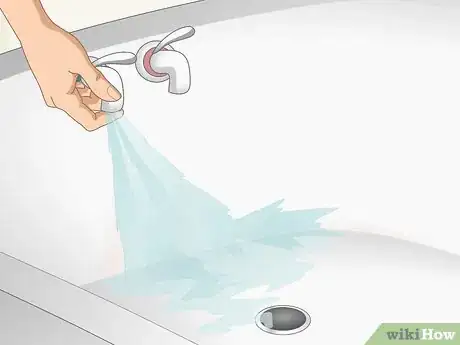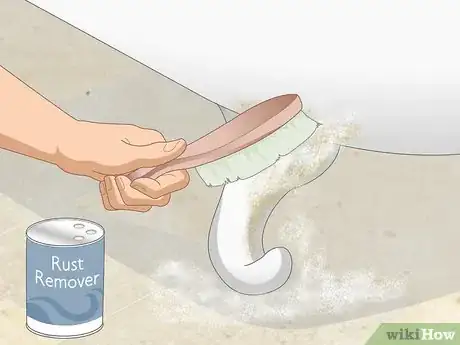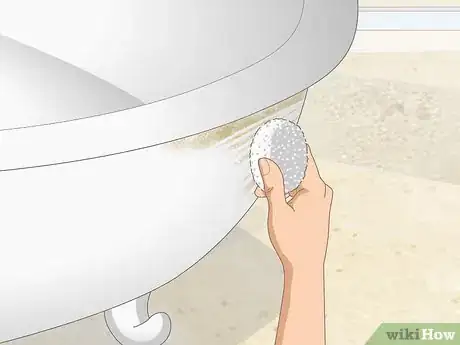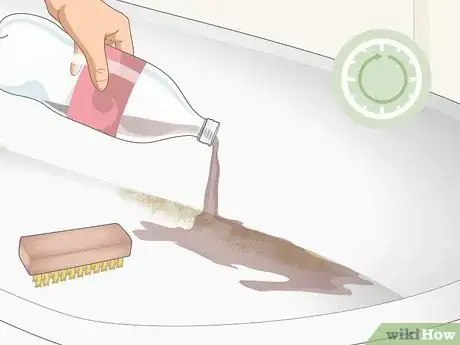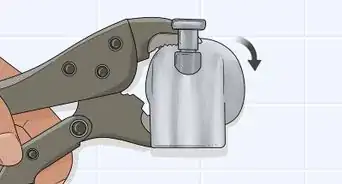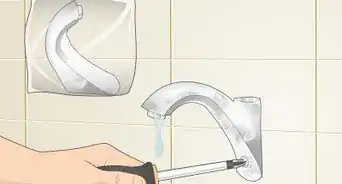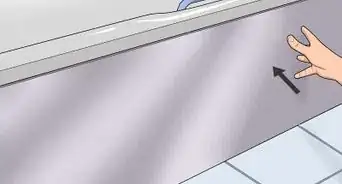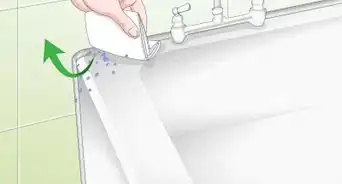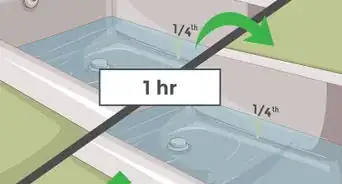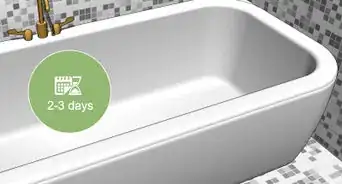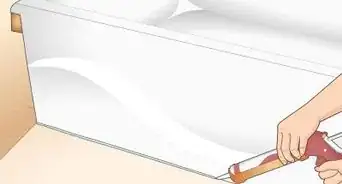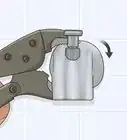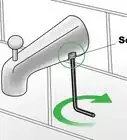This article was co-authored by Eduardo Peralta. Eduardo Peralta is a House Cleaning Specialist and the Manager of Best Maid House Cleaning based in San Jose, California. With over five years of experience, Eduardo and the Best Maid House Cleaning team specialize in home deep-cleaning, post-construction cleaning, and green and eco-friendly cleaning services. Best Maid House Cleaning is fully licensed and insured.
There are 9 references cited in this article, which can be found at the bottom of the page.
This article has been viewed 41,796 times.
You can easily remove rust from your bathtub by applying a cleaning solution and then scrubbing it from the surface. For natural cleaning mixtures, try using lemon juice and salt, or make a paste out of baking soda and vinegar. You could also use a commercial rust remover, a pumice stone to scrub rust from porcelain bathtubs, or use cola to dissolve the rust so you can scrub it away.
Steps
Using Lemon and Salt
-
1Remove rust from a flat section of any type of bathtub. The lemon juice contains a natural acid that will dissolve rust without damaging the surface of your tub. But the juice is thin and will flow away when you apply it, so use it on a flat part of the bathtub that has rust on it, such as the bottom or near the drain.[1]
- You can use sea salt or iodized table salt, but it needs to be fine in order to effectively soak up the lemon juice and form a paste.
- If your bathtub has a shelf with rust on it, you can use lemon juice and salt to remove it from there.
- If you don’t have lemons or lemon juice, you can use lime or lime juice!
-
2Cover the rust with lemon juice and let it sit for 10 minutes. Squeeze a lemon or pour bottled lemon juice over the rust spots on the bathtub. Fully saturate the affected areas and make sure the rust is covered with the juice. Allow the lemon juice to soak into the rust for at least 10 minutes.[2]
- Use as many lemons or lemon juice as it takes to cover the affected areas.
- Set a timer for 10 minutes so you can be sure the juice has had a chance to soak in.
Advertisement -
3Pour salt over the lemon juice until it forms a clumpy paste. Don’t mix or stir the solution. Sprinkle the salt over the affected areas so it sticks to the acidic lemon juice. Add enough salt to form a dry paste over the rust with the lemon juice.[3]
- Don’t dump the salt over the lemon juice. Sprinkle it slowly until it forms a slightly damp paste.
-
4Wait 2-3 hours and then scrub the rust with an old toothbrush. Use a toothbrush or a soft-bristled scrubbing brush so you don’t damage the bathtub. Once you’ve let the paste sit on the stain for long enough, take the toothbrush and scrub using circular motions until the rust disappears.[4]
- Use a microfiber cloth to scrub the rust away if you don’t have an old toothbrush or soft-bristled brush.
Cleaning Tip: For especially stubborn rust stains, let the mixture of lemon juice and salt sit on the rust for 4-5 hours, then scrub it.
-
5Rinse the paste away with clean water and wipe the area clean. Once you’ve scrubbed the rust away from the surface, wash the area with clean water to rinse away the paste. Then, take a clean cloth and wipe the area clean to remove all traces of the cleaning solution and the rust.[5]
Applying Baking Soda and Vinegar
-
1Use baking soda and vinegar on any bathtub except enamel. Baking soda and vinegar are effective rust removers, but the acid in the vinegar can degrade porcelain enamel covered bathtubs. If your bathtub is made out of anything other than porcelain enamel, then use a solution of vinegar and baking soda to remove rust from the surface.[6]
- Baking soda is also cheap and you may already have some lying around the house that you can use.
- Use white vinegar for a milder scent.
-
2Put ¼ cup (45 g) of baking soda into a bowl. Take a clean bowl and add the baking soda into it. Make sure the bowl is large enough to hold the baking soda as well as the vinegar you’ll add to it.[7]
- You can use plastic, glass, or any other type of bowl, just make sure it’s clean so you don’t scrub additional dirt or grime onto your tub.
-
3Add about 1⁄2 cup (120 mL) of white vinegar into the bowl. Fill a measuring glass with white vinegar. Slowly pour the vinegar into the bowl so you don’t send the lightweight baking soda flying everywhere. Add all of the vinegar into the bowl.[8]
-
4Stir the mixture until it forms a thick paste. Use a toothbrush or a spoon and mix the baking soda and vinegar together. Continue stirring it until it congeals into a thick but malleable paste. Make sure all of the vinegar is evenly distributed into the baking soda.[9]
- If the paste is too dry or thick, add a little bit more vinegar to loosen it up.
- Thicken a paste that’s too runny by adding a few pinches of baking soda.
-
5Use a toothbrush to spread the paste over the rust on the bathtub. Apply a thick layer of the mixture on top of the rust on your bathtub. Make sure all of the affected areas are completely covered by the paste.[10]
- Form an even layer of the paste on top of the rust.
-
6Let the paste sit on the rust overnight and then scrub it away. Allow the paste to soak into the rust overnight or for at least 8 hours so it can start to loosen it from the surface. Then, take a toothbrush or a microfiber cloth and gently scrub the affected area until the rust is gone.[11]
- Don’t scrape or scrub the bathtub too hard or you could damage or scratch the surface.
-
7Rinse the area clean with water. After you’ve scrubbed the rust away, there will be remnants of the paste and rust left on the surface. Run clean water over the area to wash the residue away from the surface.[12]
Cleaning Tip: If part of the rust remains after you scrub away the paste, repeat the process until it’s all gone.
Trying Other Solutions
-
1Apply a commercial rust remover and scrub it with a scrubbing brush. Take a commercial rust remover powder or liquid and cover the rust on your bathtub with it. If the packaging says to let it sit for a certain period of time, then allow the remover to sit. Use a stiff-bristled scrubbing brush to scrub the rust until it’s gone.[13] [14]
- Look for commercial rust removers at home improvement stores, department stores, and online.
- Popular rust removers include Iron Out, Evapo-Rust, and WD-40 Specialist Rust Remover.
- Don’t use a wire brush or steel wool to scrub the bathtub or you’ll damage the surface.
Cleaning Tip: If you don’t have a scrubbing brush, use an old toothbrush or the abrasive side of a cleaning sponge to remove the rust.
-
2Use a pumice stone to remove rust from a porcelain bathtub. Pumice is a volcanic rock that you can use to scrub away the rust from your porcelain bathtub. Soak the pumice stone in water for 5 minutes, then use light, even strokes to remove the rust from your bathtub. Then, rinse the bathtub clean to wash the rust away.[15]
- Pumice stone is very abrasive so don’t use it to scrub fiberglass or any other types of bathtubs.
- Don’t scrub too hard or you could scratch the surface of the porcelain.
- You could also scrubbing in small circles with a magic eraser dipped in diluted bleach.[16]
-
3Soak the rust in cola for 24 hours then scrub it with a scrubbing brush. Cola has citric acid that will break down the rust and the sugar and corn syrup will help it stick to the surface of the rust. Pour the cola over the rust to fully saturate it. Wait a full day and then take a stiff-bristled scrubbing brush and scrub the rust off of your tub.[17]
- Go with a nylon scrubbing brush to avoid scratching the surface of the bathtub.
- Use any standard cola such as Pepsi or Coca-Cola to soak the rust.
Expert Q&A
-
QuestionCan bleach get rid of rust?
 Eduardo PeraltaEduardo Peralta is a House Cleaning Specialist and the Manager of Best Maid House Cleaning based in San Jose, California. With over five years of experience, Eduardo and the Best Maid House Cleaning team specialize in home deep-cleaning, post-construction cleaning, and green and eco-friendly cleaning services. Best Maid House Cleaning is fully licensed and insured.
Eduardo PeraltaEduardo Peralta is a House Cleaning Specialist and the Manager of Best Maid House Cleaning based in San Jose, California. With over five years of experience, Eduardo and the Best Maid House Cleaning team specialize in home deep-cleaning, post-construction cleaning, and green and eco-friendly cleaning services. Best Maid House Cleaning is fully licensed and insured.
House Cleaning Specialist Yes, it can. You can spray a little bleach on the area and scrub it in circular motions just before rinsing.
Yes, it can. You can spray a little bleach on the area and scrub it in circular motions just before rinsing. -
QuestionHow do I repair a rusty bathtub?
 Eduardo PeraltaEduardo Peralta is a House Cleaning Specialist and the Manager of Best Maid House Cleaning based in San Jose, California. With over five years of experience, Eduardo and the Best Maid House Cleaning team specialize in home deep-cleaning, post-construction cleaning, and green and eco-friendly cleaning services. Best Maid House Cleaning is fully licensed and insured.
Eduardo PeraltaEduardo Peralta is a House Cleaning Specialist and the Manager of Best Maid House Cleaning based in San Jose, California. With over five years of experience, Eduardo and the Best Maid House Cleaning team specialize in home deep-cleaning, post-construction cleaning, and green and eco-friendly cleaning services. Best Maid House Cleaning is fully licensed and insured.
House Cleaning Specialist Rust is very difficult to clean. If the cleaning methods didn't work, you may need to recoat the tub.
Rust is very difficult to clean. If the cleaning methods didn't work, you may need to recoat the tub. -
QuestionWhat is the best rust remover for bathtubs?
 Eduardo PeraltaEduardo Peralta is a House Cleaning Specialist and the Manager of Best Maid House Cleaning based in San Jose, California. With over five years of experience, Eduardo and the Best Maid House Cleaning team specialize in home deep-cleaning, post-construction cleaning, and green and eco-friendly cleaning services. Best Maid House Cleaning is fully licensed and insured.
Eduardo PeraltaEduardo Peralta is a House Cleaning Specialist and the Manager of Best Maid House Cleaning based in San Jose, California. With over five years of experience, Eduardo and the Best Maid House Cleaning team specialize in home deep-cleaning, post-construction cleaning, and green and eco-friendly cleaning services. Best Maid House Cleaning is fully licensed and insured.
House Cleaning Specialist You should try removing it with an acidic toilet bowl cleaner. Use a product that cleans lime, rust, hard water, calcium, etc. Make sure you cover all the rust surface and scrub it well.
You should try removing it with an acidic toilet bowl cleaner. Use a product that cleans lime, rust, hard water, calcium, etc. Make sure you cover all the rust surface and scrub it well.
References
- ↑ https://www.bobvila.com/slideshow/13-unusual-tips-for-your-cleanest-bathroom-ever-48495#remove-rust-with-salt-lemon
- ↑ https://creativehomemaking.com/cleaning/bathroom/remove-rust-stains-from-porcelain-bathtub/
- ↑ https://www.bobvila.com/slideshow/13-unusual-tips-for-your-cleanest-bathroom-ever-48495#remove-rust-with-salt-lemon
- ↑ https://creativehomemaking.com/cleaning/bathroom/remove-rust-stains-from-porcelain-bathtub/
- ↑ https://www.apartmenttherapy.com/how-to-clean-an-old-porcelain-enamel-bathtub-or-sink-137148
- ↑ https://www.apartmenttherapy.com/how-to-clean-an-old-porcelain-enamel-bathtub-or-sink-137148
- ↑ https://www.apartmenttherapy.com/how-to-clean-an-old-porcelain-enamel-bathtub-or-sink-137148
- ↑ https://youtu.be/CsUBBTo3tM0?t=16
- ↑ https://youtu.be/CsUBBTo3tM0?t=16
- ↑ https://youtu.be/CsUBBTo3tM0?t=41
- ↑ https://youtu.be/CsUBBTo3tM0?t=62
- ↑ https://www.apartmenttherapy.com/how-to-clean-an-old-porcelain-enamel-bathtub-or-sink-137148
- ↑ Eduardo Peralta. House Cleaning Specialist. Expert Interview. 29 October 2021.
- ↑ https://www.bobvila.com/articles/cleaning-bathtub/
- ↑ https://creativehomemaking.com/cleaning/bathroom/remove-rust-stains-from-porcelain-bathtub/
- ↑ Eduardo Peralta. House Cleaning Specialist. Expert Interview. 29 October 2021.
- ↑ https://cleanmyspace.com/7-things-you-didnt-know-you-could-clean-with-cola/
